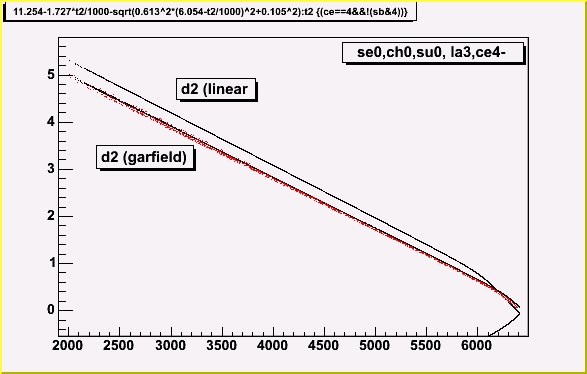hi doug,
the wire i used was: se0 ch0 su0 la2 ce4 downstream side. (so i am
actually plotting -d).
i verified that theta is indeed set to 0 and not the default. so i
just did a recrunch with theta set to default (verified with debug
statements to the terminal), tested a few events in nsed and am
recrunched the "garfield" t2d with theta=default. i attached my
resulting new t2d (red). i can't explain the increased spread the curve
or why it essentially overlaps the old curve; i will be glad if you can
double-check it.
the MPV for chisq went down from 76 -> 72, though dp went up from 31
-> 33. the numbers are a bit different from what i quoted in my talk,
but it is probably just from binning.
--chris
Douglas Hasell wrote:
> Hi,
>
> After Chris' s presentation yesterday I looked at how nsed at
> least calculates the track position and it assumes the the track
> crosses the cell at 0 degrees ie perpendicular to the chamber. I don't
> know where to look to say whether or not the reconstruction does this
> properly or not. The so called default angle which is in the wire
> calibration file varies from -53 degree for cells at 20 degrees to 8
> degrees for the cells at 80 degrees. So nsed at least does not use
> the default angle but rather fixes the track angle to be 0.
>
> Now it has been stated that using the track angle results in worse
> fits. My question here is then at what point is the proper track
> angle used? If the stubs forming the track are
when the default track angle was used, it was used right from the start
(hits&stubs), later after the first track-fit, there was the option to
adjust the hits to the correct theta.
> selected based on the results using 0 degrees and then the same stubs
> are recalculated using the track angle this may indeed result in
> poorer resolution. The proper procedure is to use the default angle
> as in the wire calibration file, determine the stubs from those
> positions which could result in different combinations of hits being
> chosen, and then refine it with the proper track angle once the track
> is found. Then the change should not be so great and possibly
> improves things. Going from 0 degrees to the actual track angle is a
> big change (eg a change of -50 degrees in the forward direction).
>
> The time to distance curve Chris showed yesterday showed the
> results of his improved fit and compared it with the "GARFIELD"
> result. Chris's result rose quickly from zero and then went linear
> about 2 mm above the GARFIELD result which rose less steeply from zero
> and then went linear. This is the behaviour using 0 degree track angle
> in a magnetic field. With higher track angles the rise is steeper. I
> suspect that if the GARFIELD result had been given the correct track
> angle the discrepancy with Chris;s result would not be as great.
>
> Chris: If you tell me which chamber, cell, layer, etc. you used in
> that plot I will calculate the correct "default" time to position curve.
>
>
> Cheers,
>
> Douglas
>
> 26-415
> M.I.T. Tel:
> +1 (617) 258-7199
> 77 Massachusetts Avenue Fax: +1 (617)
> 258-5440
> Cambridge, MA 02139, USA E-mail:
> hasell@mit.edu

This archive was generated by hypermail 2.1.2 : Mon Feb 24 2014 - 14:07:31 EST